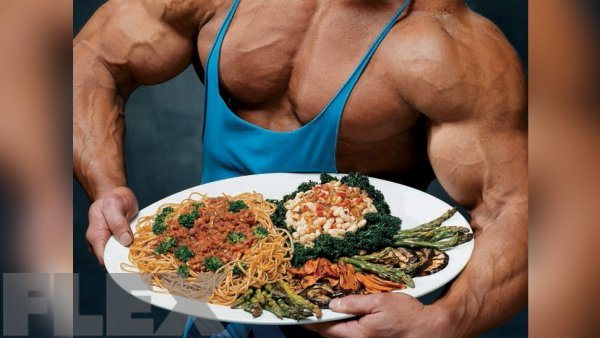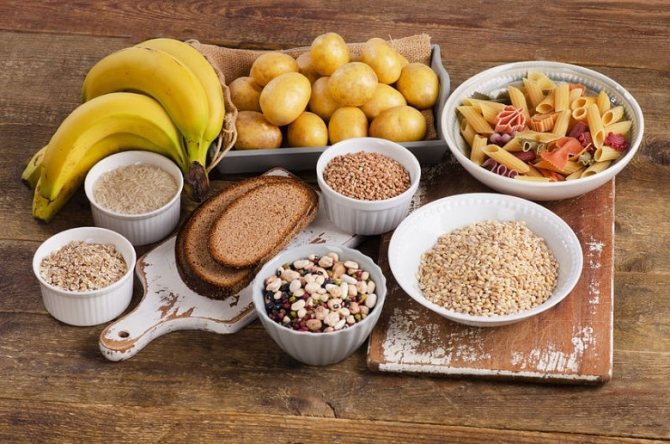How much carbohydrates should you eat to grow muscles?
Opinions of the media and athletes of strength sports on this matter vary greatly.
Therefore, many novice athletes do not quite correctly understand the role that carbohydrates play in gaining muscle mass. And one of the most common lies we hear all the time is that they are our worst enemy and should be avoided.
Many of us have been conditioned to believe that we should try to limit them as much as possible because carbs are sugar, sugar makes us fat, and fat is bad...right?
Not really.
As you know, protein is primarily necessary for muscle growth, but carbohydrates also play an important role in maintaining and gaining muscle mass.
neither participate in many biochemical processes and provide the body with energy for regular effective training.
It is important to take them into account when drawing up a nutrition plan, and for this you need to know the best sources of carbohydrates for athletes, and be able to correctly calculate their amount.
How many carbohydrates per day do you need?
It is recommended that 40-60% of daily calories come from carbohydrates.
Most people would agree that approximately half of our calories should come from carbohydrates, and this ratio is ideal for both men and women.
How many grams is this?
You can easily calculate based on the fact that 1 gram of carbohydrates equals 4 calories. Let's say you need to consume 3,000 calories a day to gain muscle mass.
50% of the diet equals 1500 calories. At 4 calories per gram (1500 divided by 4 equals approximately 375 grams) of carbohydrates each day.{banner_st-d-2}
Your calorie intake will vary depending on your individual goal and basal metabolic rate (BMR).
To gain mass, for example, you will need to consume 300-500 calories more than this level. If you are cutting, this number will be 300 - 500 calories lower.
Calculation per day
Now let's do a little math: We calculate the daily calorie requirement using the formula:
Your weight (in kilograms) multiplied by 30
Let's assume that you need about 2900 calories per day to gain muscle mass.
You intend to get 45% of this from carbohydrates. 45% of 2900 = 1305. Now take that answer and divide by 4: 1305: 4 = 326. Voila! The calculation is over, we got the right amount - 326 grams of carbohydrates per day. Let's take it a step further... You plan to consume anywhere from 4 to 6 meals per day - we'll use 5 as an example. 326: 5 meals = 65 g carbohydrates per meal. Now you know how to calculate the daily amount, the ideal ratio and how to distribute carbohydrate intake throughout the day.
Of course, you don’t need to complicate your life and strive to calculate everything to the most precise numbers, this is just an example of calculation. Including the right amount of quality carbohydrates in our diet is important specifically for optimizing muscle gain during strength training.
Healthy carbohydrates: list of foods for weight loss
Carbohydrates are a type of organic substance that our body needs every day, along with proteins and fats.
What types of carbohydrates are there?
All carbohydrates can be divided into three large groups. Let's look at them:
- Simple carbohydrates are carbohydrates based on glucose, fructose, lactose or sucrose. Products containing simple carbohydrates are most often treated with particular caution - after all, these are pastries, cakes, sweet soda, milk chocolate, honey, chips. It is products from this subgroup that most often become the culprits of extra folds at the waist. However, do not forget that fruits and berries are also rich in simple (or fast) carbohydrates, with which the body receives vitamins and beneficial biologically active substances, so you should not completely exclude simple carbohydrates from your diet. Nutritionists recommend including simple carbohydrates (preferably in the form of berries and fruits) in your daily calorie intake and consuming them, if possible, in the first half of the day.
- The next group is complex digestible carbohydrates. These are carbohydrates that basically contain starch. Starch accounts for the majority of the carbohydrates a person consumes daily. Starch is found in grains (bread, flour, cereals) and legumes, as well as potatoes. This subgroup of nutrients is very important for humans, since it is complex digestible carbohydrates, for example, cereals and whole grain bread, that provide us with the main energy during the day. You can feel this yourself: after having breakfast with porridge with berries, you will feel slightly hungry only towards lunch, while after sweet tea with cookies, you will want to eat within an hour.
- And another important group is complex indigestible carbohydrates. The products from this subgroup are based on fiber and cellulose. Such carbohydrates are found in vegetables, fruits and greens. Indigestible carbohydrates are called so because our digestive system is not able to digest and assimilate them. But despite this, they are very important for the body, since they are sources of dietary fiber that nourish the normal intestinal microflora. Foods rich in fiber normalize the functioning of the gastrointestinal tract and provide good immunity in general. In this group of carbohydrates, you should give preference to greens and vegetables, preferably fresh and not thermally processed ones, as well as non-sweet fruits. Between juice and whole fruit, choose the latter - the fruit contains more fiber and less sugar.
How are carbohydrates digested?
Essentially, your body converts any carbohydrate you eat into glucose. However, complex carbohydrates take longer to be absorbed by the body - for this reason, they are sometimes called “slow” carbohydrates. When complex carbohydrate molecules are broken down, there is no sudden release of glucose into the blood; it is released gradually, satisfying a person’s energy needs for several hours.
In order for carbohydrates to be friends and not enemies in your diet, you need to know and pay attention to such a value as the glycemic index of the product. The glycemic index shows how quickly the body absorbs a particular product that is a source of carbohydrates. The higher the glycemic index, the greater the jump in blood glucose levels caused by eating it. For example, sweet yeast baked goods, milk chocolate, and French fries have a high glycemic index. Eating these products is harmful not only to your figure, but also to your health in general, because it can provoke the development of serious diseases (for example, type 2 diabetes). Nutritionists advise paying attention to the glycemic index of the foods you include in your diet. When creating your daily menu, try to ensure that it contains foods with a glycemic index of no higher than 50.
How many carbohydrates do you need per day?
Carbohydrates are an important source of energy for our body, since it is glucose that fuels the brain. For this reason, you cannot create a significant carbohydrate deficit in your diet even if you want to lose a few extra pounds. But do not forget about the norm of carbohydrate consumption. In the most general case, for young women with a moderately active lifestyle who do not have the goal of losing weight, the rate of consumption of these nutrients is calculated using the formula 4-5 g of carbohydrates per 1 kg of weight per day. Try to ensure that a significant portion of your daily carbohydrate intake comes from complex digestible carbohydrates.
What foods to look for healthy carbohydrates in.
Nutrition experts recommend including the following types of carbohydrates in your diet daily:
- - cereals. Unpolished rice and buckwheat are especially useful. Don't limit yourself to the usual types of cereals, try new flavors - for example, bulgur, quinoa.
- - legumes: chickpeas, lentils, beans, peas.
- — vegetables and herbs are an irreplaceable source of fiber. Just be careful with potatoes and beets, as these vegetables have a fairly high glycemic index.
- - fruits and berries. These foods contain vitamins and minerals necessary for the body that cannot be obtained from other foods. However, do not forget that fruits and berries are sources of simple carbohydrates, so it is better to limit their amount to 400-500 grams per day and consume them in the first half of the day, before 16-17 hours.
All of the above products can and should be included in your diet, even if your goal is weight loss. However, do not forget about calorie standards - if you exceed the amount of even healthy carbohydrates in your diet, weight gain is inevitable.
It is better to limit the following products in the diet, and if the goal is to lose weight, even transfer them to the “black list”:

- Sugar. Try to develop the habit of drinking unsweetened drinks. But at the initial stage, when you find it difficult to come to terms with life without a sweet taste, use natural, safe sweeteners, such as stevia.
- Sugar containing products. Cakes, sauces, preserves and jams, confectionery, sweet carbonated drinks - manufacturers add a significant amount of sugar to these products, which many people needlessly do not take into account when counting calories.
- Bakery products made from premium flour are a source of fast carbohydrates; it is better to replace them with pasta made from wholemeal flour and whole grain yeast-free bread.
- Breakfast cereals and instant cereals (from bags) do not contain healthy complex carbohydrates, but they contain a lot of sugar.
Products from this list should be limited not only to those who are losing weight, but also to people who adhere to a healthy diet, since their excess in the diet can provoke various diseases. In accordance with WHO recommendations from 2015, sugar and sugar-containing products (cookies, gummies, etc.) are recommended to be limited to 4-5% of the total daily intake of carbohydrates. For example, this is about 4-5 teaspoons of sugar per day for a young woman with an average weight of 60 kg who is not trying to lose weight.
Do not forget that if you adhere to proper nutrition, regardless of whether your goal is to lose weight or you want to maintain your current shape, you need to include foods containing healthy carbohydrates in your diet every day. Give preference to the “right” carbohydrates, pay attention to the glycemic index of the foods you eat, and do not forget that if you eat harmoniously and nutritiously, not forgetting a sense of proportion, you can keep your body in great shape without the help of diets.
Best Sources of Carbohydrates
While carbohydrates are undeniably important, consuming them incorrectly can be detrimental to your health. Eating candy that consists primarily of sugar (high glycemic index) will certainly not improve your overall physical condition. Processed foods with added sugars are also poor dietary choices.
It is advisable to limit yourself to only eating foods that are high in nutrients and have a low or medium glycemic index:
- Brown Basmati Rice
- Bran bread
- Coarse pasta
- Cereals (oatmeal, buckwheat, corn)
- Brown brown rice
- Green vegetables and tomatoes
- Low-fat cottage cheese
- Chinese noodles and vermicelli
Not banned, but under suspicion
Numerous popular diets have developed in most of us a disdainful and even sharply negative attitude towards carbohydrate-containing foods.
There are methods that are based on the consumption of foods low in sugars, and there are those in which they are completely prohibited because they cause a sharp increase in body weight. But is this really so and why can’t we completely give up bread, corn, legumes, and sweet fruits, if we believe the statement that they are so harmful? In order to tell which foods are those that contain simple and complex carbohydrates, we must explain the nature of the compounds themselves, which nutritionists are afraid of.
So, we have before us organic substances that have a number of properties:
- Perform energetic and structural functions.
- They are part of complex proteins.
- They cannot be synthesized by the body - we get them exclusively from food.
Products related to essential sources of carbohydrates, a list of which we will give later, are divided into those that contain lighter and more complex compounds. We will tell you more about them below.
Nutrition before and after training
Exception #1
constitutes a pre-workout meal: 1 hour before exercise, it is recommended to take carbohydrates with a high glycemic index (kefir, low-fat yogurt, jam, boiled potatoes or gainer) - at the rate of 1 gram of carbohydrates per 1 kg of body weight.

Exception #2:
post-workout nutrition. To replenish lost energy, ideally you need to take up to 100 g of carbohydrates with an average glycemic index within 30 minutes. This is extremely difficult to do due to lack of appetite, and this is where sweet drinks containing 10 grams of protein per 100 grams of carbohydrates come to our aid. The presence of protein in such drinks activates the enzyme glycogen synthetase, which accelerates the process of glycogen production and replenishment of its reserves in the muscles and liver. If instead we take whey isolate of free amino acids, then a mechanism called gluconeogenesis is activated - this is when glucose is synthesized from amino acids, which is deposited in glycogen stores. This pathway is not efficient and there is no need to force the body to engage in gluconeogenesis if free carbohydrates can be provided to replenish glycogen stores.
What are carbohydrates?
In simple terms, a carbohydrate is a compound made up of carbon, oxygen and hydrogen. Fiber, sugar and starch are all forms of carbohydrates and can be classified as simple or complex.
Mono- and disaccharides are “simple” because they consist of one or two sugar molecules.
Polysaccharides are “complex,” long-chain carbohydrates and contain monosaccharide units.
Glucose, fructose and galactose are the three primary monosaccharides from which all carbohydrates are formed, and although each monosaccharide contains carbon, oxygen and hydrogen, their respective combinations in the molecule differ, giving them different qualities, not least taste.
Disaccharides include sucrose, lactose and maltose, and polysaccharides include starch, glycogen and fiber.{banner_st-d-1}
Simple or fast
This group includes compounds that contain 1-2 molecules. These substances are divided into 2 types.
Monosaccharides
During hydrolysis, their structure does not undergo changes - they do not break down into simpler components. Distinctive features: sweetness, rapid dissolution in water.
This group includes:
- Glucose is the most common light carbohydrate, which is rich in berries and fruits. The second name for this compound is dextrose. Its remains are building material for more complex substances (such as glycogen and starch). There is also glucose in sucrose. This is a valuable source of energy, without which the heart, brain and many tissues would be left without nutrition. Its absorption is impossible without the participation of insulin, a hormone that regulates carbohydrate metabolism. The consequence of its insufficient production is the development of diabetes.
- Galactose is also a simple sugar and is found in dairy products and some energy drinks. The substance in question is formed as a result of the hydrolysis of lactose, and in the liver it is converted into the already described glucose.
- Fructose is another monosaccharide. It is not involved in replenishing glycogen reserves, is absorbed more slowly, and acts as one of the main ingredients in sports drinks and nutrition. This is the sweetest of sugars and is best obtained from fruits and berries. An excess of this substance can lead to problems with the heart, liver, and the development of metabolic syndrome - metabolic disorders.
Disaccharides
These polyfunctional compounds consist of 2 molecules of simple substances, which were mentioned above. The most famous of them:
- Lactose – found in milk and dairy products, plays an important role in the development of a child and is the main component of baby food. Cleavage occurs in the gastrointestinal tract under the influence of the enzyme lactase. In adults, lactase activity is lower than in children. This leads to the formation of intolerance to whole milk.
- Maltose – This variety is rarely seen in its free form. Most often it is presented in grains of barley, rye, products made from malt, and molasses. Also present in tomatoes and some plants.
- Sucrose is a combination of glucose and fructose, one of the most effective immunosuppressants. This substance does not exist in nature. It was synthesized artificially - in man-made beets and sugar cane.
Metabolism of carbohydrates in the body
All carbohydrates are nutrients that our body uses to produce glucose, our body's most preferred source of fuel.
Glucose serves as a source of energy and its content in the bloodstream is surprisingly very low - approximately 0.1% of the human bloodstream, where it ends up after absorption from the intestines.
Some of the glucose is used for vital functions, and the rest is stored in the muscles and liver as glycogen, a reserve that can be quickly used when blood glucose levels drop between meals.
When the maximum storage capacity in the liver and muscles is exceeded, the “extra” glucose is converted into fat, a stable molecule for long-term calorie storage that is used when there is a shortage of carbohydrates.
But if carbohydrate reserves are depleted, then the first thing our body begins to use as an energy source is the protein of our long-suffering muscles! This is why it is so important to constantly maintain adequate levels of glycogen in the liver and muscles. In this case, food protein is used for its intended purpose - as a building material for building muscles, and not as an auxiliary source of energy.
Carbohydrates also regulate blood sugar, nourish healthy gut flora (friendly bacteria that help digest food and strengthen the immune system), promote calcium absorption, improve brain function, and in the case of fiber, lower cholesterol (low-density lipoprotein).
Additional Products
To diversify your sports diet, you should know about foods with carbohydrates for gaining muscle mass and what additional nutrients they contain:
- Sunflower seeds. Source of protein and vitamin E. Reduces the negative effects of free radicals on muscle cells and restores them.
- Mackerel. Omega-3 fatty acids slow down the body's breakdown of protein until after exercise, another source of protein enters the stomach and is digested. Fish eaten for breakfast will have the same effect, even if enough time has passed before the start and end of the workout. And vitamin C, like collagen, is needed for the elasticity of muscles and ligaments.
- A pineapple. This fruit contains the enzyme bromelain, which helps digest proteins. It also reduces the muscle pain threshold after exercise.
- Venison. The meat of forest animals contains a lot of vitamin B12. This vitamin actively digests protein necessary for muscle growth. The main thing is to cook it correctly so that the meat is not tough.
- Coffee. Reduces muscle pain, thereby increasing the duration of training. Can be replaced with green tea.
- Beef. The best of all types of meat for an athlete's diet. Contains amino acids and creatine, which increase muscle mass and reduce fat mass. Promotes physical endurance.
- Ginger. The best pain reliever, of natural origin.
- Natural yogurt. Natural yoghurts are healthier because they contain fewer chemical additives and sugar. If desired, you can add fresh fruit. Lactic acid bacteria stimulate digestion and absorption of large doses of protein.
- Turmeric. The spice affects the restoration and growth of new cells, so necessary after strength training.
- Cucumbers. It is the cucumber peel that contains substances that strengthen the connective tissue of the human body.
- Milk. Muscles and bones need calcium. Give preference to milk with 3.5 percent fat content.
- Buckwheat. This cereal is rich in amino acids, which strengthen blood vessels and promote muscle growth. Strengthening blood vessels is important, since power loads significantly strain the circulatory system.
- Almonds. Vitamin E from almonds restores muscle cells faster after workouts. Daily dose – 8-10 pieces of sweet nut. In addition to physical strength, almonds improve your mood.
- Paste. Natural applesauce pastille is perfect if you want something sweet. It has a minimal amount of fat and calories, but a lot of protein.
- Eggs. In addition to protein, chicken eggs contain vitamin D, which is good for the elasticity of muscles and ligaments. However, you should not consume more than ten pieces per week.
- Tuna. One hundred percent protein. Consume one hour after strength training.
- Sweet red pepper. Contains a large amount of vitamin C, and without this antioxidant it is almost impossible to gain muscle mass. Choose only very red peppers.
- Lentils. Source of protein, iron, zinc. An important product for a sports diet.
- Asparagus. Champion in protein content, as well as potassium, zinc and fiber.
- Spirulina algae. This product consists of 65 percent protein, beta-carotene. It is recommended to add it to cocktails after consulting with your doctor, as it is a medicinal dietary supplement.
- Water. During the entire workout, be sure to drink water, as it quickly leaves the body. And a large loss of fluid prevents the body from working in the right direction.

So, the opinion that carbohydrates are evil and should be consumed as little as possible is wrong. The problem is not the carbohydrates themselves, but what they are, and how often we consume simple, quickly digestible substances that provide instant energy, thereby deceiving the body. Properly selected and planned nutrition will not only preserve your health, but also make your body beautiful and pumped up.
"Good" and "Bad"
Carbohydrates for muscle gain - macronutrient
So far we have painted a rather rosy picture. Are there any downsides to this tasty macronutrient?
Answer: Depends on the circumstances.
Just as fats can be “good” or “bad,” the same applies to carbohydrates. But what defines them as such?
First of all, you need to figure out whether it is a simple or complex carbohydrate.

As discussed above, these terms refer to the number of bonded sugar molecules in a molecule. Complex “slow” carbohydrates are often called “good” carbohydrates because their molecular complexity (relative to mono- and disaccharides) makes them slow to digest.
Their glycemic load is low - they raise blood sugar levels less and more slowly than simple, “fast” sugars.
In contrast, simple carbohydrates are often called "bad" carbohydrates because their molecular structure allows them to be quickly digested and absorbed into the bloodstream, causing blood sugar levels to spike. And the faster and more pronounced this increase, the more insulin levels rise, leading to an increased risk of diabetes, obesity, premature aging, cardiovascular disease, endocrine disorders and insulin resistance.
Diet
What an approximate diet should look like:
- Morning. For breakfast, carbohydrates are required to gain muscle mass, and not fast ones, but complex ones, for example, oatmeal with fruit or honey.
- Dinner. During lunch, consume the most calories of the day. Without this, muscles will not grow, and fat deposits will also be minimized.
- Day. A healthy snack can consist of dried fruits, nuts or an omelette.
- Dinner. Light protein foods, such as lean fish or meat, with stewed vegetables in olive oil. Buckwheat is a source of carbohydrates.

Allies in gaining muscle mass
While it is true that in the absence of carbohydrates in the diet, the body begins to burn stored fat as an energy source, the desire of some athletes to sharply reduce their carbohydrate intake to reduce body fat may be unwise.
Carbohydrates—especially complex carbohydrates with a low to medium glycemic index—are an excellent source of energy and the body's most common and effective fuel. Proper use of them allows athletes to train harder, increase strength, gain muscle mass, while burning fat and improving body structure.
In fact, severe carbohydrate restriction may prevent adequate exercise. When blood glucose levels drop and glycogen stores are depleted, your brain and muscles are deprived of their favorite fuel, leading to decreased drive, strength and endurance, and even poorer mental performance.
Of course, not all carbohydrates are created equal.
Chronic overconsumption of white bread and snack foods can lead to nutritional deficiencies, low energy levels and a distinctly unathletic physique.
Whenever possible, try to consume slow-burning, fiber-rich carbohydrates. Combine them with enough quality protein and healthy fats and see how your strength and fitness levels will improve!
Athlete's diet
A sports diet involves determining the calorie content of all food consumed in order to determine how many carbohydrates are needed to gain muscle mass, and what is their daily requirement, in combination with fats and proteins. To grow muscles, a man needs to increase his caloric intake per day by about 20 percent. The average daily intake is 2700-3000 calories.
It is important that the products contain the most correct carbohydrates and fats, otherwise the diet will lead to a set of fat deposits rather than muscle growth.
How much carbohydrates, fats and proteins to eat to gain muscle mass:
- fats should make up 30-35 percent of daily calories, preferably in the form of vegetable oil,
- carbohydrates, only with a low glycemic index, about 50-60 percent,
- proteins – no more than 25 percent.












